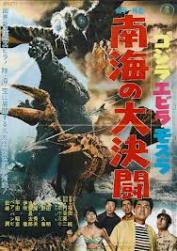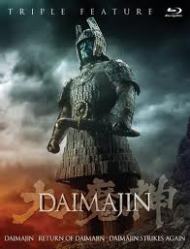Gamera’s rocket is struck by a meteor, returning him to earth where he vanishes from the movie for nearly an hour. Meanwhile, three men (who I think might be low level gangsters—it isn’t clear) head to New Guinea to recover an opal that our more-or-less hero’s brother hid during WWII. The opal is not a stone, but an egg, which hatches Barugon who grows into a giant monster and attacks Japan.
In a series that drifted more and more childish with each new film, the second Gamera movie fouled up that curve by being substantially less goofy than its predecessor, in large part because it is the only Gamera Showa film without a child as a major character. Rumors claim that the island dancing girls were initially planned to be topless, and several scenes, while innocent (depending on what you think about blood licking), are suggestive of oral sex. The end product is juvenile, just much less juvenile than the rest of the franchise. You can only be so mature with a monster that shoots rainbows and is a guy crawling around on all fours.
The film is odd in another way—it is hardly a Gamera movie and I suspect the original script didn’t contain him. Gamera has only a few minutes of screen time, in re-used footage at the beginning, a brief battle two-thirds in, and then a final brawl, and he has nothing to do with the rest of the story. If you made one of the military plans more successful, you could have written him out.
The two leads, Keisuke the fortune-hunter and Kara (always subtitled as Karen) the island girl, are handled unusually well. They don’t do much, but Keisuke isn’t embarrassing—which is very rare for a human in a Gamera movie) and Kara is captivating. She’s portrayed by Kyoko Enami, one of the great beauties of Japanese cinema.
The giant monster fights are silly, but no more silly than in other daikaiju flicks of the time, and a good deal less than Godzilla vs. the Sea Monster and Son of Godzilla which came out within a year.
While you can now find an English subtitled version of Gamera vs Barugon, it was originally released in the US in a cut and dubbed form as War of the Monsters. Twelve minutes were cut, all of which involved the leads discussing plans with the military. Their loss makes the film more nonsensical (where did that giant diamond come from and why are they suddenly in a helicopter?) but doesn’t do substantial damage. And the dubbing is surprisingly good.
My rating is a bit high, but any daikaiju fan should see one of the early Gamera films, and the rating indicates that this is the one.






